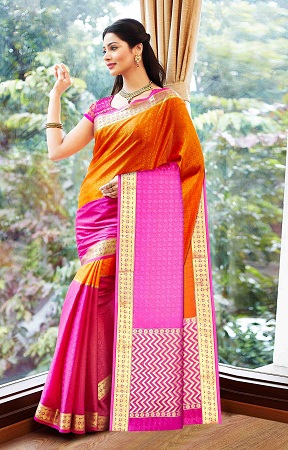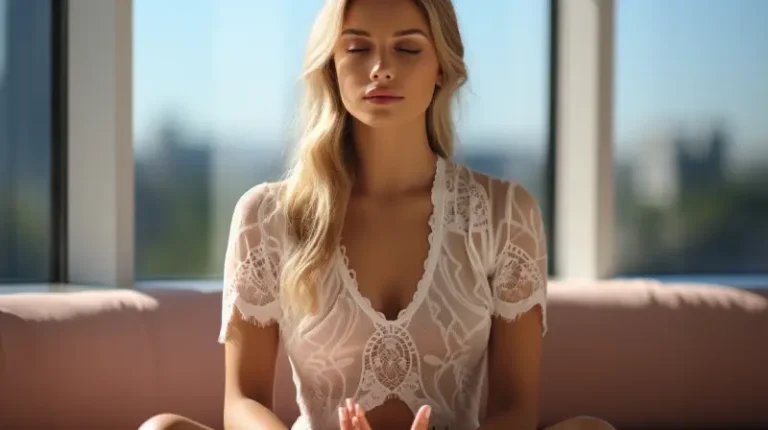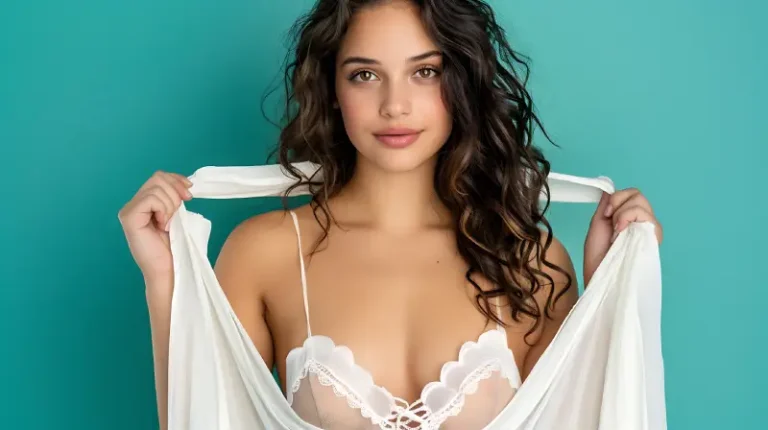
Discover Indian Silk Sarees
Silk sarees are being worn in India from time immemorial. They are a part of Indian culture and society with many references from earliest times regarding the way women draped them and the way it enhanced their beauty.
A wide variety of silk sarees are made in India with most of them deriving their name from the region where they are made. Each of these sarees is unique in the sense that all of them are made with the emotion and imagination of the craftsman. The craftsmen use vibrant colours to the fabric, create beautiful textures and make beautiful floral, geometrical and other designs to catch the fascination of the women buying the saree.
Type of Silk Saris
There are basically four types of silk that are produced in India namely the Mullburry, Muga, Tussar and Eri. Tussar and Eri are produced by tribals in various parts of the country and are the most abundantly produced silk varieties in India. Traditional sarees like the Kanjeevaram sarees, Mysore silk sarees, Baluchari sarees, Patola Sarees, Chanderi sarees, Paithani Sarees are made by artisans using pure silk as the base material.
Silk sarees are made in a number of regions in the country with some centres promoting a certain weaving style or design. Some of the famous silk centres in India are as under:
Andhra Pradesh – Dharmavaram, Pochampalli, Venkatgiri, Narainpet
Assam – Sualkuchi
Bihar – Bhagalpur
Gujarat – Surat, Cambay
Jammu & Kashmir – Srinagar
Karnataka – Bangalore, Anekal, Ilkal, Molakalmuru, Melkote, Kollegal
Chhattisgarh – Champa, Chanderi, Raigarh
Maharashtra – Paithan
Tamilnadu – Kanchipuram, Arni, Salem, Kumbhkonam, Tanjavur
Uttarpradesh – Varanasi
West Bengal – Bishnupur, Musrshidabad, Birbhum
Silk Saris of Banaras
Situated on the banks of Ganges is the holy city of Banaras or Varanasi. The city is not only famous for the famous academic centres like the Banaras Hindu University but also for the Banarasi silk sarees. Women love to wear Banarasi silk sarees as they are adorned with intricately woven rich motifs of leaves, flowers, fruits, birds etc. The sarees come in soft colour background and are enriched with intricately designed borders and heavily decorated pallus.
Banaras is also famous for its gauzi silver and gold tissues that are very light weight and delicate. You can also get the famous Kinkab which is a glittering weave of gold and silver threads.

Kancheepuram Silk Saris
Kancheepuram silk sarees are unique as they use colour contrasts that are very different from those being used by any other silk saree weavers. These sarees use pyramidical temple borders, checks, stripes and floral designs with the border, body and pallu being separately woven and interlocked afterwards. The interlocking joints in the saree are very strong and do not detach at any point of time.
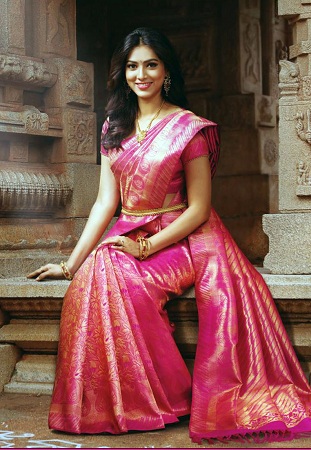
Konrad Silk Saris
Konrad silk saree or the temple saree comes from Tamil Nadu. These sarees are wide bordered sarees and were originally woven for temple deities and have motifs like peacock, elephants that symbolize water, fertility and creativity. These sarees come in the shades of browns, grey and off- white.
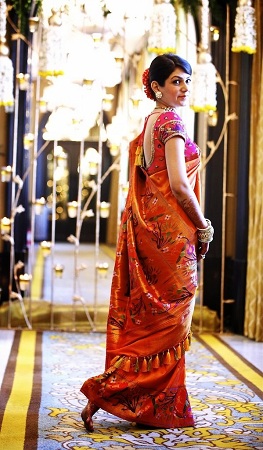
Thanchoi Silk Saris
Thanchoi silk sarees are one of the most admired sarees in India. Thanchoi is basically an art of weaving which is close to the weaving style used in Banarasi sarees. Thanchoi sarees are woven in such a way so as to give a raised effect like brocade. These sarees do not have a border but the difference between the pallu and the border is very distinct. These sarees usually have floral motifs.

Ilkal and Patola Silk Saris
Ilkal also known as Patola in Orissa is a tie and dye method which is applied to the yarn before the start of weaving. There are two methods of dying in this system. In one way the tie and dye method is used to the warp only and in the second method the tie and dye method is applied to the warp and weft.
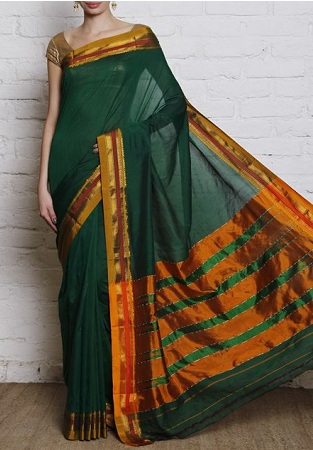
Bandhni silk Saris
Bandhni sarees come from Gujarat and Rajasthan and are amongst the most popular silk sarees in every woman’s saree collection. Bandhni sarees look very exquisite and are worn by many celebrities in the Indian film industry during their official functions and private parties. Bandhni sarees are produced following the ancient method of tie and dye called Bandhej. In this method of tie and dye, designs are created on natural colour cloth by tying a thread around certain areas and dipping the cloth in the dye. The thread is removed afterwards and the areas covered by thread retain their original colour while the rest of the cloth is coloured in the colour of the dye.
Depending on the design of the saree, the method can be repeated a number of times to achieve the required design and colour combination.
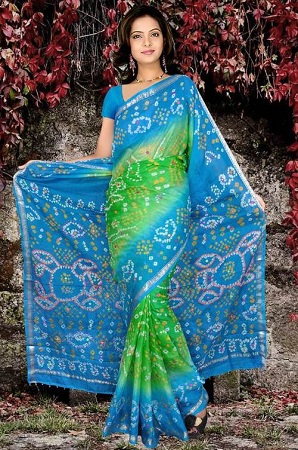
Chanderi and Maheshwari Silk Saris
Chanderi and Maheshwari silk sarees are produced in Madhya Pradesh and are the traditional sarees of the region. These sarees are light weight and are usually meant for the summers. They are produced both in silk as well as in cotton and usually have designs taken from Chanderi temples. These sarees usually made in green or purple colour with Zari border.
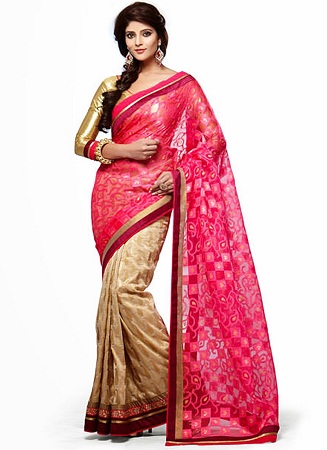
Baluchari Silk Saris
These are the traditional silk sarees from Bengal having 5 yard length and 42” wide flam. These sarees usually come in red, purple and deep blue colour having small butis with beautiful floral designs running across the edges in the entire field of the saree. The anchal or the pallu is the best part of the saree and is highly decorated with narrative motifs.
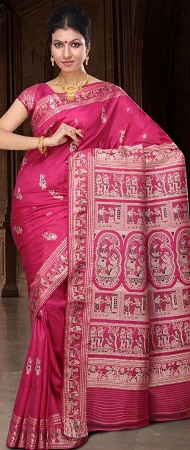
Tussar Silk Saris
Tussar or Kosa silk is the most abundant type of silk produced in India. The silk sarees from the fabric are valued for the texture and purity of fabric along with the natural shades like honey, tawny, cream, beige etc. Tussar silk sarees come in a range of colours with natural motifs and are available in both modern and contemporary designs.
Today plain tussar and mixed tussar- cotton sarees are woven to compliment the budget of all types of households however the pure tussar silk sarees in contemporary designs are still a big rage amongst the women of all generations.
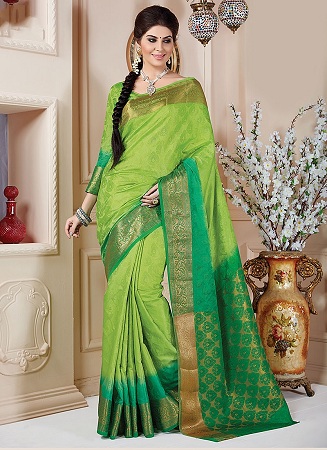
Paithani Silk Saris
These sarees gain their name from a village near Aurangabad in Maharashtra. Paithani silk sarees are very beautiful and are covered with motifs like parrots, trees, plants. These sarees come in shades like magenta, peacock and purple with the pallu or border in gold and pattern in silk giving the entire look of the saree an embossed design.
These sarees are very expensive as they involve enormous amount of labour, skill and huge expanse of material.
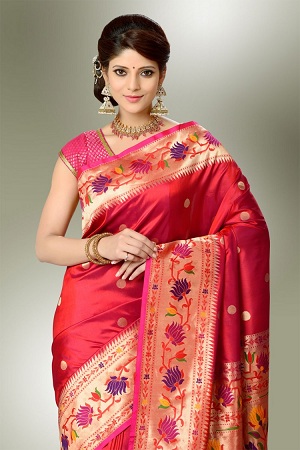
Mysore Silk Saris
Considered at par with Kancheepuram silk sarees, Mysore silk sarees are predominantly worn by brides across the country irrespective of their religion. The weaving of the saree is heavy and authentic with a zari and a golden lace at the edge giving a classy and sleek look. The saree has become an addiction for all the women as a preferred drape for parties and formal functions.
The Mysore silk was originally the fabric for the royalty of Mysore but now has become the choice of the upper class and celebrities in India.
